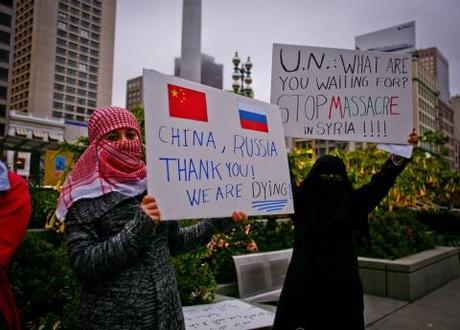
Protests against the crackdown in Syria. Photo credit: Yunchung Lee, www.flickr.com/photos/bleuman/5706355818/
The death toll in Syria continues to rise following a military crackdown on Sunday. President Bashar al-Assad sent armoured divisions to Hama, the city at the centre of recent anti-government protests. While exact figures are unavailable, Al Jazeera estimated that the bombardment has claimed nearly 142 lives across the country. International leaders have condemned the continuing violence and threatened further sanctions against the regime; but will this have any effect?
Hama was the site of a massacre in 1982 on the orders of President Hafez al-Assad, father of the current president. Estimates of the number of casualties range from 10,000 to 40,000.
- “Full-on warfare.” Hama has been outside government control since a wave of protests against the Syrian regime in June, with protestors taking to the streets every Friday. As Ramadan begins, CNN reported that hospitals in Hama are unable to cope with the influx of the wounded, and that morgues are overflowing. The reaction of the regime has been predictable: official state news agency SANA reported that President al-Assad had made a speech to the army insisting that “all of Syria’s honest people are confident that we will emerge from the crisis more powerful, more present and more effective regionally and internationally.” But a US embassy spokesman told the BBC the latest military assault amounted to “full-on warfare by the Syrian government on its own people”, according to The Guardian. Reporting from Damascus, BBC journalist Lina Sinjab pointed out that the violence is not confined to Hama, even though the city has endured most deadly assault so far. Writing in The Telegraph, Michael Weiss argued that other Syrian cities would soon face similar attacks: “According to my sources, the regime’s plan is to lay siege to rebel cities sequentially rather than all at once whilst also consolidating its security and military forces into a hardcore of Alawite loyalists.” When Assad took power in 2000, he was initially seen as a more liberal leader than his father, who ruled the country for almost 29 years. However, opposition sources estimate that more than 14,000 Syrians have been killed since protests demanding democratic reforms began in May.
- Media power. Although international news organisations are mainly banned from Syria, video clips have emerged that appear to show civilians in the city taking cover amid gunfire and heavy shelling; on one such clip from the Al Jazeera website, the cameraman can be heard praying for his life. The Washington Post speculated that the use of phone cameras may lessen the casualties – for now, at least: “Assad likely understands that he cannot risk the kind of heavy-casualty attack on Hama that worked for his father—those phones are watching—which is why he has had to calibrate his use of force.” However, Weiss argued in The Telegraph that Assad is now so isolated from the international community that the fear of exposure would have little effect.
“The use of force against civilians and representatives of state structures is unacceptable and must cease,” said the Russian Foreign Ministry on Monday. Source: Reuters.

